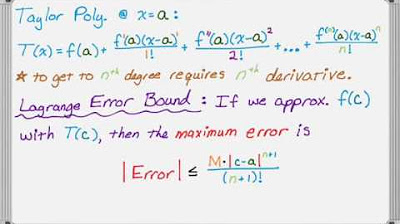Worked example: estimating sin(0.4) using Lagrange error bound | AP Calculus BC | Khan Academy
TLDRThe video script discusses the process of estimating the sine of 0.4 using a Maclaurin polynomial and determining the least degree of the polynomial to ensure an error margin below 0.001. It introduces the concept of Taylor's Remainder Theorem, also known as the Lagrange error bound, to calculate the remainder of the nth degree Maclaurin polynomial. The instructor uses the bounded nature of the sine function's derivatives to apply the error bound, iteratively testing degrees until finding that a fourth-degree polynomial sufficiently approximates sine(0.4) with the desired accuracy.
Takeaways
- 🔢 The goal is to estimate the sine of 0.4 using a Maclaurin polynomial and determine the smallest polynomial degree that ensures an error smaller than 0.001.
- 📈 The Maclaurin polynomial provides an approximation of a function, with some remainder representing the error of the approximation.
- 📏 The problem involves finding the smallest degree n of the polynomial such that the remainder at x = 0.4 is less than 0.001.
- 📊 The Lagrange error bound (also known as Taylor's Remainder Theorem) is used to estimate the error of the polynomial approximation.
- ✍️ The theorem states that if the (n+1)th derivative of the function is bounded by some value M, then the remainder is bounded by M times (x^(n+1))/(n+1)!.
- 🧮 For the sine function, all its derivatives are bounded in absolute value by 1, making M = 1 for this problem.
- 📉 The error bound formula for this case becomes (0.4^(n+1))/(n+1)!, and we seek n such that this expression is less than 0.001.
- 🔍 The instructor calculates the error for different values of n, starting from n = 1 and increasing until the error bound is sufficiently small.
- 📝 Through calculations, it is found that for n = 4, the error bound becomes less than 0.001, indicating that a 4th-degree polynomial is sufficient.
- ✔️ The conclusion is that a 4th-degree Maclaurin polynomial provides an approximation of sine(0.4) with an error smaller than 0.001.
Q & A
What is the main topic discussed in the video script?
-The main topic discussed in the video script is estimating the sine of 0.4 using a Maclaurin polynomial and determining the least degree of the polynomial that ensures an error smaller than 0.001.
What is a Maclaurin polynomial?
-A Maclaurin polynomial is a type of Taylor polynomial that is centered at zero. It is used to approximate functions by expressing them as a series of terms calculated from the derivatives of the function at a single point, typically zero.
What is the concept of 'remainder' in the context of Maclaurin polynomials?
-The 'remainder' in the context of Maclaurin polynomials refers to the difference between the actual function value and the value of the polynomial approximation at a given point. It represents the error in the approximation.
What is the purpose of using the Lagrange error bound in this context?
-The purpose of using the Lagrange error bound is to estimate the maximum possible error in the polynomial approximation. It helps determine the degree of the polynomial needed to ensure that the error is within a specified tolerance, such as less than 0.001.
What is Taylor's Remainder Theorem, as mentioned in the script?
-Taylor's Remainder Theorem, also known as the Lagrange error bound, provides a way to estimate the error in a Taylor series approximation. It states that the error is bounded by the absolute value of the (n+1)th derivative of the function, evaluated at some point within the interval, multiplied by the (n+1)th power of the distance from the center of the series, divided by (n+1) factorial.
Why is the sine function a good candidate for this type of approximation?
-The sine function is a good candidate for this type of approximation because its derivatives are all bounded by one. This property simplifies the calculation of the Lagrange error bound and makes it easier to determine the degree of the polynomial needed for a given error tolerance.
How does the script determine the least degree of the polynomial for the sine function?
-The script determines the least degree of the polynomial by calculating the Lagrange error bound for increasing degrees (n) and checking when the bound becomes less than 0.001. This involves calculating the (n+1)th derivative of the sine function, evaluating it at 0.4, and comparing the result to the desired error tolerance.
What is the significance of the factorial in the Lagrange error bound formula?
-The factorial in the Lagrange error bound formula, specifically (n+1) factorial, acts as a scaling factor that decreases as n increases. This ensures that the error bound decreases as the degree of the polynomial increases, reflecting the improved accuracy of the approximation.
What is the conclusion reached in the script regarding the least degree of the polynomial for the sine function at 0.4?
-The conclusion reached in the script is that the least degree of the polynomial that ensures an error smaller than 0.001 for the sine function at 0.4 is the fourth degree. This is verified by calculating the Lagrange error bound for n=4 and confirming that it is less than 0.001.
How does the script illustrate the process of finding the least degree of the polynomial?
-The script illustrates the process by incrementally increasing the degree of the polynomial (n), calculating the Lagrange error bound for each degree, and checking when the bound falls below the threshold of 0.001. This is done through a step-by-step calculation and comparison.
Outlines
📚 Estimating Sine with Maclaurin Polynomials
This paragraph discusses the process of estimating the sine function using a Maclaurin polynomial. The main focus is on determining the least degree of the polynomial that ensures the error is less than 0.001. The instructor introduces the concept of a Maclaurin polynomial as an approximation of a function and the associated error or remainder. The problem is rephrased to find the smallest 'n' such that the remainder of the nth degree Maclaurin polynomial at x=0.4 is less than 0.001. The Lagrange error bound, also known as Taylor's Remainder Theorem, is introduced as a tool to solve this problem. The theorem states that if the (n+1)th derivative of a function is bounded by M over an interval containing the center of the polynomial (in this case, zero), then the remainder of the nth degree polynomial is less than or equal to M times x^(n+1) divided by (n+1) factorial. The instructor then applies this theorem to the sine function, noting that the absolute value of the sine function and its derivatives are all bounded by one, which simplifies the calculation of the error bound.
🔍 Applying the Lagrange Error Bound to Sine Function
In this paragraph, the instructor applies the Lagrange error bound to the sine function to find the least degree of the Maclaurin polynomial that ensures an error less than 0.001. The process involves calculating the value of 0.4^(n+1) divided by (n+1) factorial for different values of 'n'. The instructor starts with n=1 and increases the value of 'n' until the calculated value is less than 0.001. The calculations show that for n=1, the value is 0.08, which is greater than 0.001. For n=2, the value is approximately 0.01, still not meeting the requirement. When n=3, the value is slightly more than 0.001. Finally, for n=4, the calculated value is less than 0.001, confirming that the fourth degree Maclaurin polynomial evaluated at x=0.4 will have a remainder less than 0.001. This confirms that the least degree of the polynomial that meets the error requirement is four.
Mindmap
Keywords
💡Maclaurin Polynomial
💡Error
💡Taylor Polynomial
💡Remainder
💡Lagrange Error Bound
💡n-th Degree
💡Derivative
💡Sine Function
💡Absolute Value
💡Factorial
💡Table
Highlights
Estimating sine of 0.4 using a Maclaurin polynomial and ensuring an error smaller than 0.001.
Introduction to nth degree Maclaurin polynomials as an approximation method for functions.
Discussion on the error or remainder associated with polynomial approximations.
The problem of finding the least degree of the polynomial for a specific error threshold.
Introduction of Lagrange error bound, also known as Taylor's Remainder Theorem.
Explanation of how the absolute value of the nth derivative of a function affects the error bound.
Application of the error bound formula to the specific problem of sine function approximation.
Understanding that the derivatives of sine are bounded by one, simplifying the error bound calculation.
Using the bounded nature of sine's derivatives to apply the Lagrange error bound effectively.
Calculation of the error bound for different degrees of the Maclaurin polynomial.
Demonstration of increasing n to find when the error bound becomes smaller than 0.001.
Practical approach to finding the least degree n where the error bound condition is met.
Verification through calculation that a fourth-degree Maclaurin polynomial meets the error requirement.
Conclusion that the least degree of the polynomial that ensures an error smaller than 0.001 is four.
Emphasis on the practicality of using the Lagrange error bound for polynomial approximation errors.
Highlighting the importance of understanding the derivatives' behavior in polynomial approximation.
The method's applicability to other functions and intervals beyond the sine function and 0.4.
Transcripts
Browse More Related Video

Worked example: estimating e_ using Lagrange error bound | AP Calculus BC | Khan Academy

Avon High School - AP Calculus BC - Topic 10.12 - Example 2

Avon High School - AP Calculus BC - Topic 10.12 - Example 3

The Lagrange Error Bound for Taylor Polynomials

2023 AP Calculus BC FRQ #6

Avon High School - AP Calculus BC - Topic 10.12 - Example 1
5.0 / 5 (0 votes)
Thanks for rating: